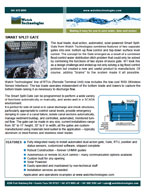Smart Split Gates
Two styles, Standard and Imperial, with two blades in one frame doing the work of at least two gates; undershot and overshot options in one gate. Single or double stem actuation to accommodate any size gate.
-
The Standard has an upper blade to control upstream checking, level control, or overshot flow that can drop down to "capture" the lower blade and raise it for sluicing, large flow dumps, or to get both blades out of the way for maintenance.
-
The Imperial also has two blades but each is separately actuated to control undershot and overshot flow simultaneously with the capability for raising both blades completely out of the way; the best Check structure ever made.
Specifications Summary
| Gate Type | Rising or non-rising stem, any size |
| Control Options | Maintain up or downstream level or flow, adjust gate position and/or equipment operations on data input based on a schedule; custom programming available |
| Power- Typ Max Daily | 12 and 24 VDC, WT-100 4 Amp-hr/day, WT-200 6 Amp-hr/day, WT-300 9 Amp-hr/day |
| Controller I/O | RUG3 – 6 analog, 8 digital, 4 digital out (10A relays), 4 analog out, enhanced IO and customcontrollers available |
| Control Panel | HOA, local manual up/down, off, auto for remote control telemetry (SCADA) |
| Patent pending |
Installing WT's Flood Control Split-Gate
MEDFORD, OREGON: Watch Technologies is unique amongst Sluice Gate (a.k.a Slide Gate) manufacturers in many ways: we provide fully integrated systems and services. This project required a 7’ x 11’ x 17’ 304 Stainless Steel WT Smart Split-Gate equipped with a WT-200 solar-powered smart actuator programmed for fully stand-alone operation or remote control by radio link. WT provided design, manufacturing, integration, and installation for the project taking full responsibility from conception to commissioning and support.
On-line since 2010, the gate automatically controls head-level in canals upstream of the gate thereby controlling head in an irrigation take-off canal at the top of the diversion structure. This is achieved while simultaneously adjusting flow over the top of the upper blade until emergency flood levels upstream of the gate in the flood control system dictate opening the bottom blade to provide major discharge into Bear Creek during significant weather events. This prevents extreme flow from flooding surrounding city streets.

